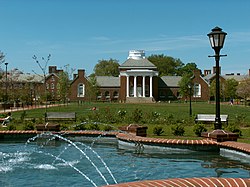This article needs additional citations for verification .(November 2025) |

The University of Delaware Botanic Gardens are botanical gardens and an arboretum located on the campus of the University of Delaware, in Newark, Delaware, United States. The gardens are open to the public without charge. [1]
Contents
- List of tree and shrub species in collection
- A
- B
- C
- D
- E
- F
- G
- H
- I
- J
- L
- M
- N
- O
- P
- Q
- R
- S
- T
- V
- W
- Z
- See also
- References
- External links
The original garden in front of Townsend Hall was established with a donation from Emily Clark Diffenback in the mid-1960s, and has been named Clark Garden in her honor. It has since been designated a test arboretum by the American Holly Society. Other gardens include a Magnolia Society test garden south of Townsend Hall; native and non-native plants north of Worrilow Hall; a wildflower area in front of the Fischer Greenhouse Laboratory; a herbaceous perennial garden behind another greenhouse; and stretches of native trees and shrubs lining the driveway and grounds.
